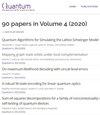Tensor Product Structure Geometry under Unitary Channels
IF 5.1
2区 物理与天体物理
Q1 PHYSICS, MULTIDISCIPLINARY
引用次数: 0
Abstract
In quantum many-body systems, complex dynamics delocalize the physical degrees of freedom. This spreading of information throughout the system has been extensively studied in relation to quantum thermalization, scrambling, and chaos. Locality is typically defined with respect to a tensor product structure (TPS) which identifies the local subsystems of the quantum system. In this paper, we investigate a simple geometric measure of operator spreading by quantifying the distance of the space of local operators from itself evolved under a unitary channel. We show that this TPS distance is related to the scrambling properties of the dynamics between the local subsystems and coincides with the entangling power of the dynamics in the case of a symmetric bipartition. Additionally, we provide sufficient conditions for the maximization of the TPS distance and show that the class of 2-unitaries provides examples of dynamics that achieve this maximal value. For Hamiltonian evolutions at short times, the characteristic timescale of the TPS distance depends on scrambling rates determined by the strength of interactions between the local subsystems. Beyond this short-time regime, the behavior of the TPS distance is explored through numerical simulations of prototypical models exhibiting distinct ergodic properties, ranging from quantum chaos and integrability to Hilbert space fragmentation and localization.求助全文
约1分钟内获得全文
求助全文
来源期刊

Quantum
Physics and Astronomy-Physics and Astronomy (miscellaneous)
CiteScore
9.20
自引率
10.90%
发文量
241
审稿时长
16 weeks
期刊介绍:
Quantum is an open-access peer-reviewed journal for quantum science and related fields. Quantum is non-profit and community-run: an effort by researchers and for researchers to make science more open and publishing more transparent and efficient.
 求助内容:
求助内容: 应助结果提醒方式:
应助结果提醒方式:


